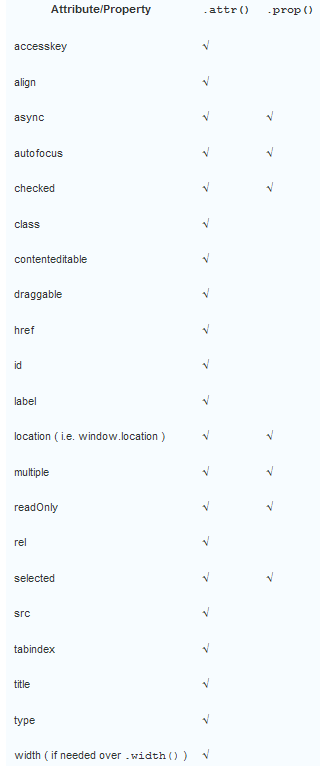相比attr,prop是1.6.1才新出來的,兩者從中文意思理解,都是獲取/設置屬性的方法(attributes和properties)。只是,window或document中使用.attr()方法在jQuery1.6之前不能正常運行,因為window和document中不能有attributes。prop應運而生了。
既然我們想知道他們兩的區別,最好就看看他們的源代碼,不要被代碼長度所嚇到,我們只看關鍵的幾句:
attr: function( elem, name, value, pass ) {
var ret, hooks, notxml,
nType = elem.nodeType;
// don't get/set attributes on text, comment and attribute nodes
if ( !elem || nType === 3 || nType === 8 || nType === 2 ) {
return;
}
if ( pass && jQuery.isFunction( jQuery.fn[ name ] ) ) {
return jQuery( elem )[ name ]( value );
}
// Fallback to prop when attributes are not supported
if ( typeof elem.getAttribute === "undefined" ) {
return jQuery.prop( elem, name, value );
}
notxml = nType !== 1 || !jQuery.isXMLDoc( elem );
// All attributes are lowercase
// Grab necessary hook if one is defined
if ( notxml ) {
name = name.toLowerCase();
hooks = jQuery.attrHooks[ name ] || ( rboolean.test( name ) ? boolHook : nodeHook );
}
if ( value !== undefined ) {
if ( value === null ) {
jQuery.removeAttr( elem, name );
return;
} else if ( hooks && "set" in hooks && notxml && (ret = hooks.set( elem, value, name )) !== undefined ) {
return ret;
} else {
elem.setAttribute( name, value + "" );
return value;
}
} else if ( hooks && "get" in hooks && notxml && (ret = hooks.get( elem, name )) !== null ) {
return ret;
} else {
ret = elem.getAttribute( name );
// Non-existent attributes return null, we normalize to undefined
return ret === null ?
undefined :
ret;
}
}
prop方法代碼(jQuery版本1.8.3)
prop: function( elem, name, value ) {
var ret, hooks, notxml,
nType = elem.nodeType;
// don't get/set properties on text, comment and attribute nodes
if ( !elem || nType === 3 || nType === 8 || nType === 2 ) {
return;
}
notxml = nType !== 1 || !jQuery.isXMLDoc( elem );
if ( notxml ) {
// Fix name and attach hooks
name = jQuery.propFix[ name ] || name;
hooks = jQuery.propHooks[ name ];
}
if ( value !== undefined ) {
if ( hooks && "set" in hooks && (ret = hooks.set( elem, value, name )) !== undefined ) {
return ret;
} else {
return ( elem[ name ] = value );
}
} else {
if ( hooks && "get" in hooks && (ret = hooks.get( elem, name )) !== null ) {
return ret;
} else {
return elem[ name ];
}
}
}
attr方法裡面,最關鍵的兩行代碼,elem.setAttribute( name, value + “” )和ret = elem.getAttribute( name ),很明顯的看出來,使用的DOM的API setAttribute和getAttribute方法操作的屬性元素節點。
而prop方法裡面,最關鍵的兩行代碼,return ( elem[ name ] = value )和return elem[ name ],你可以理解成這樣document.getElementById(el)[name] = value,這是轉化成JS對象的一個屬性。
既然明白了原理是這樣,我們來看看一個例子:
<input type="checkbox" id="test" abc="111" />
$(function(){
el = $("#test");
console.log(el.attr("style")); //undefined
console.log(el.prop("style")); //CSSStyleDeclaration對象
console.log(document.getElementById("test").style); //CSSStyleDeclaration對象
});
el.attr(“style”)輸出undefined,因為attr是獲取的這個對象屬性節點的值,很顯然此時沒有這個屬性節點,自然輸出undefined
el.prop(“style”)輸出CSSStyleDeclaration對象,對於一個DOM對象,是具有原生的style對象屬性的,所以輸出了style對象
至於document.getElementById(“test”).style和上面那條一樣
接著看:
el.attr("abc","111")
console.log(el.attr("abc")); //111
console.log(el.prop("abc")); //undefined
首先用attr方法給這個對象添加abc節點屬性,值為111,可以看到html的結構也變了
el.attr(“abc”)輸出結果為111,再正常不過了
el.prop(“abc”)輸出undefined,因為abc是在這個的屬性節點中,所以通過prop是取不到的
el.prop("abc", "222");
console.log(el.attr("abc")); //111
console.log(el.prop("abc")); //222
我們再用prop方法給這個對象設置了abc屬性,值為222,可以看到html的結構是沒有變化的。輸出的結果就不解釋了。
上面已經把原理講清楚了,什麼時候用什麼就可以自己把握了。
提一下,在遇到要獲取或設置checked,selected,readonly和disabled等屬性時,用prop方法顯然更好,比如像下面這樣:
<input type="checkbox" id="test" checked="checked" />
console.log(el.attr("checked")); //checked
console.log(el.prop("checked")); //true
console.log(el.attr("disabled")); //undefined
console.log(el.prop("disabled")); //false
顯然,布爾值比字符串值讓接下來的處理更合理。
PS一下,如果你有JS性能潔癖的話,顯然prop的性能更高,因為attr需要訪問DOM屬性節點,訪問DOM是最耗時的。這種情況適用於多選項全選和反選的情況。
大家都知道有的浏覽器只要寫disabled,checked就可以了,而有的要寫成disabled = "disabled",checked="checked",比如用attr("checked")獲取checkbox的checked屬性時選中的時候可以取到值,值為"checked"但沒選中獲取值就是undefined。
jq提供新的方法“prop”來獲取這些屬性,就是來解決這個問題的,以前我們使用attr獲取checked屬性時返回"checked"和"",現在使用prop方法獲取屬性則統一返回true和false。
那麼,什麼時候使用attr(),什麼時候使用prop()?
1.添加屬性名稱該屬性就會生效應該使用prop();
2.是有true,false兩個屬性使用prop();
3.其他則使用attr();
項目中jquery升級的時候大家要注意這點!
以下是官方建議attr(),prop()的使用:
以下是官方建議attr(),prop()的使用:
